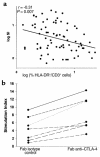Chronic immune activation associated with intestinal helminth infections results in impaired signal transduction and anergy
- PMID: 11032865
- PMCID: PMC314342
- DOI: 10.1172/JCI10182
Chronic immune activation associated with intestinal helminth infections results in impaired signal transduction and anergy
Abstract
Helminthic parasites cause widespread, persistent infections in humans. The immigration of Ethiopians to Israel (a group denoted here by "Eth."), many of them infested with helminths and in a chronic immune-activation state, enabled us to investigate the effects of such immune activation on immune responses. We studied the immune profile and immune functions of 190 Eth. and Israeli non-Eth. (Isr.) highly, partially, or non-immune-activated individuals. Immune cells from highly immune-activated individuals were defective in several signaling responses, all of which were restored gradually following anti-helminthic treatment. These cells showed poor transmembrane signaling, as seen by the phosphorylation of various tyrosine kinases and of the MAPK kinases, ERK1/2 and p38; deficient degradation of phosphorylated IkappaBalpha; increased expression of cytotoxic T lymphocyte-associated antigen 4 (CTLA-4), which appears to block proliferative responses in these cells; decreased beta-chemokine secretion by CD8(+) cells after stimulation; and reduced proliferation to recall antigen stimulation. Highly immune-activated individuals also showed decreased delayed-type skin hypersensitivity responses to recall antigen before deworming. These findings support the notion that chronic helminthic infections cause persistent immune activation that results in hyporesponsiveness and anergy. Such impaired immune functions may diminish the capacity of these individuals to cope with infections and to generate cellular protective immunity after vaccination.
Figures





References
-
- Chan MS. The global burden of intestinal nematode infections: fifty years on. Parasitol Today. 1997;13:438–443. - PubMed
-
- Dye D, Scheele S, Dolin P, Pathania V, Raviglione MC. Global burden of tuberculosis: estimated incidence, prevalence, and mortality by country. JAMA. 1999;282:677–686. - PubMed
-
- Satcher D. The global HIV/AIDS epidemic. JAMA. 1999;281:1479. - PubMed
-
- Nahmias J, et al. Health profile of Ethiopian immigrants in Israel: an overview. Isr J Med Sci. 1993;29:338–343. - PubMed
-
- Bentwich Z, Kalinkovich A, Weisman Z. Immune activation is a dominant factor in the pathogenesis of AIDS in Africa. Immunol Today. 1995;16:187–191. - PubMed
Publication types
MeSH terms
Substances
LinkOut - more resources
Full Text Sources
Research Materials
Miscellaneous

